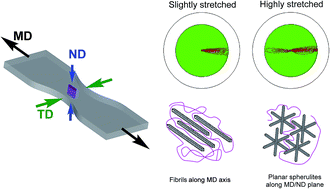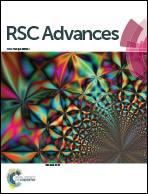Three-dimensional orientation of poly(l-lactide) crystals under uniaxial drawing†
Abstract
In this work the effects of three-dimensional crystal development upon polymer stretching are investigated. Poly(L-lactide) has been selected as a model semicrystalline polymer owing to its high chain stereoregularity which enables its crystallization by strain-induced mechanism. Specimens containing a bulk crystal volume fraction up to 55.5% have been obtained. Fourier transform infrared spectroscopy (FTIR) proves the development of more densely packed domains with strong dipole–dipole interactions for the more stretched PLLA. X-ray diffraction (XRD) has been implemented to obtain insights about the occurring micro-structural changes. Additionally, to determine macromolecular orientations texture analysis using XRD has been performed via pole figure measurements, which demonstrate that crystalline domains are transformed from fibrils into planar spherulites as stretching evolves. It is proposed that the strain-induced crystallization mechanism upon stretching is governed by the decrease of the number of degrees of freedom for the crystallization process when the compression is enough to limit one of the possible orientations. Obtained morphological evidences for the suggested crystal transformations by field emission scanning electron microscopy (FE-SEM) further confirm our hypothesis. In future, the analysis of three-dimensional strain-induced crystal orientation would be of prime interest for other commonly used semicrystalline polymers such as isotactic polypropylene (iPP), polyethylene (PE), polyethylene terephthalate (PET) and polyamide 66 (nylon).


 Please wait while we load your content...
Please wait while we load your content...